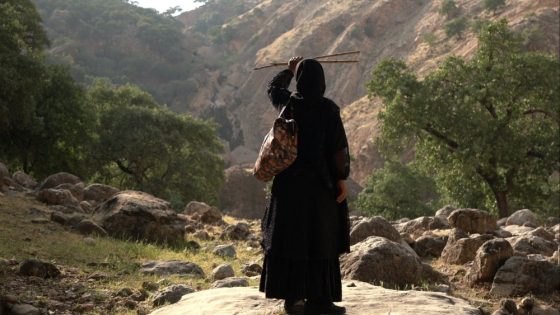Iranian filmmaker Marjan Khosravi, winner of multiple awards for her shorts, is bowing her first feature-length film, “Requiem for a Tribe,” at the Shanghai International Film Festival. The film is in the documentary competition and eligible for a Golden Goblet.
Khosravi has an awards-laden career. Earlier this year, she won awards at Hot Docs and Fribourg for her short documentary “Mrs. Iran’s Husband” and at Budapest for “The Dream of a Horse.” Her mid-length documentary “The Snow Calls” premiered at IDFA in 2020 and won a prize at the Big Sky Documentary Film Festival.
“Requiem for a Tribe” follows Hajar, a 55-year-old woman from southwestern Iran’s Bakhtiari tribe who is betrayed by her family and forced to abandon a nomadic lifestyle. The film is set in a context where climate change, urbanization and social issues have drastically diminished the traditional migratory activities of the tribe.
Khosravi has an intimate knowledge of the Bakhtiari nomads because she is one of them. She was born in a Bakhtiari village and lived there until 2015 when the family, which includes her brother and producer Milad, moved to Tehran to continue studying and to pursue their dreams of working in cinema. City life was attractive for the Khosravis, but Marjan and Milad’s mother became depressed because she was used to the countryside, surrounded by natural beauty.
Marjan Khosravi was working as an assistant director when she met Hajar Faramarzi. “She talked about her memories of migration for hours. She was just like my mother and grandmother who was longing for the beautiful memories of the colorful nature and nomadic lifestyle that she had in her childhood and youth period,” Khosravi told Variety.
In order to cheer up her mother, Khosravi was constantly showing her videos of nomadic migrations. One of these was Anthony Howarth’s 1976 documentary on the Bakhtiaris called “People of the Wind” and Faramarzi was one of the characters in that film. “I immediately figured out that Hajar and her personal story is the concept of my new film and I decided to make a film about her and all the other women like her: traditional women and their struggles with modern life. Their families always decide for them, yet they are never happy with these decisions. These women are not heard by anyone,” Khosravi said.
An ongoing issue the team faced was the rapid spread of modernity in nomadic areas, which resulted in a yearly decrease in the number of nomadic tribes. They were migrating to cities or villages, and now, very few nomadic tribes remain. Those who do migrate no longer do so on foot but by vehicle, Khosravi said.
“As a result, we had to change the film’s editing several times over these years to create a cohesive narrative with a proper linear story and an ending that matched both the story and reality. However, I am happy that after these years, we were able to create this important research work to show how the lifestyles are changing constantly and how modernization is destroying all of the traditions without considering the consequences, through a true story,” Khosravi added.
The Khosravis began shooting “Requiem for a Tribe” in 2018 as a small self-financed project. The film took off when Spanish producer Stephanie von Lukowicz (“Kinderbilder aus Sarajevo”) watched “The Snow Calls” on the IDFA platform and appreciated Marjan’s work. Under von Lukowicz’s guidance began a long global funding journey that tapped into sources as diverse as the Hot Docs CrossCurrents fund, the Hot Docs pitch Prize, DMZ Pitch prize, AJB DOCS, Sunny Side of the Doc, which helped the team get the Aljazeera Documentary Channel on board, and the Doha Film Institute post-production fund. The team also negotiated with Milestone Films, owner of the “People of the Wind,” to clear the rights for archival material used from the film.
“Financing for Iranian independent films is so tough and sometimes impossible. There are some resources for films which are not truly independent from the ministry of culture, but for the independent films in Iran there are no public funds,” Milad Khosravi told Variety. “There are a lot of talented filmmakers in Iran who are not able to make their films independently and most of the time they try to finance their film with the private investment in the country, which is not the best possible option. Private and self-investment resources are always so limited, weak financing structures decrease the quality of the productions and limit their storytelling abilities.”
“Most recently, theatrical release for the independent films in Iran has decreased significantly. Therefore private investors that were willing to invest in such films are less than ever,” Milad Khosravi added. “On the other hand, Iran lacks cultural treaties with other countries, both within the [Middle East] region and globally, [while] international sanctions make official co-productions with other nations extremely difficult. As a result, independent filmmakers like us are unable to benefit from public funds of other countries.”
Nevertheless, the Khosravis soldier on. After the festival run they plan to disseminate “Requiem for a Tribe” in the MENA region via their partner Al Jazeera and also give it a theatrical release in the Bakhtiari regions of Iran. They are also working on another film called “Dreams of Wild Oaks,” which has a story set in the same region.
Marjan Khosravi, Milad Khosravi
Seven Springs Pictures
Source Agencies



